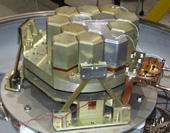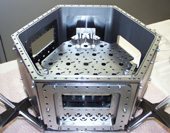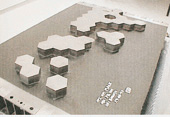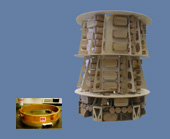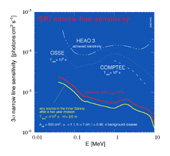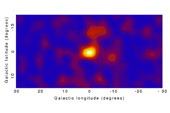The INTEGRAL mission
A major step in exploring the high-energy Universe is ESA’s INTEGRAL mission which has been launched October 17, 2002 into a High Eccentric Orbit.
Its two main instruments, SPI and IBIS, cover complementary aspects to obtain the broadest possible astrophysical information : the spectrometer SPI offers excellent narrow line sensitivity and provides an extended source imaging capability. The imager IBIS provides the complement of fine imaging; it also has useful sensitivity to broad lines and continuum emission.
The INTEGRAL payload is completed by two monitor instruments covering the main instrument FOVs and providing concurrent monitoring of gamma-ray targets in the X-ray (2-100 keV) and optical domains.
INTEGRAL is an observatory type mission. Most of the observing time, the “general program”, is awarded to the scientific community at large.
The INTEGRAL science data center (ISDC) performs data preprocessing, spots potential targets of opportunity (response within 24 hours) and archives the data which are made available to the scientific community.
The European Space Agency ESA is responsible for the overall spacecraft and mission design, instrument integration, systems test and spacecraft operations.
The spectrometer SPI
The INTEGRAL spectrometer SPI features a compact array of high purity Germanium detectors cooled by a Stirling cooler system and shielded by a massive anticoincidence system.
A coded mask modulates the astrophysical signal. SPI performs spectral analysis of high-energy sources in the energy range between 20 keV - 8 MeV such as supernovae remnants, novae, compact Galactic sources, annihilation sites, Active Galactic Nuclei etc.
The anticipated performance for narrow line spectroscopy is characterized by an energy resolution in the parts per thousand range, an angular resolution of order 2.5° within a fully coded field of view of 16°, and a sensitivity 3-7 10-6 ph cm-2.s-1 in the energy range relevant for nuclear astrophysics.
Collaborating scientific institutes are :
-
France (CESR Toulouse, CEA Saclay, CNES Toulouse)
-
Germany (MPE Garching)
-
Italy (IFCTR Milano)
-
Spain (U. Valencia)
-
Belgium (U. Louvain)
-
United Kingdom (U. Birmingham)
-
Poland (CBK Warshaw)
-
USA (UC San Diego, LBL Berkeley, NASA/GSFC Greenbelt).
SPI scientific objectives
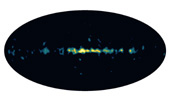
SPI provides high resolution spectroscopy with superior sensitivity and covers a wealth of scientific objectives ranging from compact sources as broad class annihilators, through long-lived galactic radioisotopes such as 26Al with hotspots in the degree-range to the extremely extended galactic disk and bulge emission of the narrow e+e- line.
Gamma-ray lines are the fingerprints of nuclear transitions, carrying the memory of high energy processes in the universe. Gamma-ray spectroscopy is thus a unique tool to identify the presence of excited nuclei, quantitatively determine their abundance’s, and provide insight into the physical conditions of the source regions (temperature, density, gravitational or cosmological energy shifts).
The “fine spectroscopy / coarse imaging” concept of SPI is particularly appropriate to nuclear astrophysics since phenomena such as the diffusion of radioactive isotopes into the interstellar medium often lead to narrow lines emitted on a broad angular scale, whereas gamma-ray line emissions from violent compact objects are more likely to be spectrally broadened.
Nevertheless, SPI also improves our understanding of compact objects - galactic and extragalactic - through the observation of spectral features such as cyclotron lines.
Germanium detectors
The detector array consists of 19 n-type germanium detectors, with a total geometric detection area of 500 cm2. The individual detectors have a hexagonal shape, 3.2 cm on a side, 7 cm deep, and a center-to-center distance of 6 cm. They are mounted inside a partially pressurized Al capsule.
The preamplified signal of each detector is fed into an analog front-end electronics (AFEE) system where it is amplified, filtered and converted in 32000 channels that are split into two energy ranges.
In order to reduce internal background produced by ß decays inside the Ge detectors, a Pulse Shape Discrimination (PSD) system also receives the preamplified signal.
By distinguishing single site interactions (predominantly caused by ß decays) and non-localized interactions (primarily produced by gamma-rays), the PSD improves the sensitivity by about a factor of two between 200 keV and 1.5 MeV.
The information of the PSD and AFEE are then time-tagged and formatted by the digital front end electronics (DFEE) before being sent to the digital processing electronics (DPE).
At CESR (Toulouse, France), the detector array and analog front-end electronics have been developed, while CEA (Saclay, France) provided the digital front-end electronics.
The Ge crystals were produced by Hoboken under the responsibility of Louvain University (Belgium). The PSD has been developed by UC Berkeley and UC San Diego, (USA), and has been integrated in the camera system by CESR
Cryostat
The Ge detector array is mounted on a Beryllium plate and cooled to an operating temperature of 85 K.
A Be cold finger carries heat through the BGO shield towards the Stirling cryo coolers on the outside of the instrument.
The Ge detector assembly is completely enclosed by a Beryllium cryostat, which is itself thermally isolated and passively cooled to 210 K.
This is achieved by a radiator connected to the cryostat via ammonia-filled heat pipes.
The use of Beryllium for the cryostat helps to keep the background due to passive material inside the shield as low as possible, while ensuring the highest possible transmission for gamma-rays from astrophysical sources.
CNES Toulouse (France) has developed the cryostat and has been responsible for the mechanical, thermal, software and electrical design, the general design specifications, both internal and external interfaces, and SPI integration activities.
The cryocoolers have been provided by ESA.
Coded mask
The aperture system providing the imaging capabilities of the instrument is a coded mask 171 cm above the detector.
The mask pattern is a hexagonal uniformly redundant array (HURA) with 127 elements.
The 63 opaque mask elements are 3 cm thick tungsten hexagons, 6 cm center-to-center.
They assure a signal modulation of more than 90% over SPI’s energy range.
The 64 transparent elements are characterized by the honeycomb mounting plate which absorbs less than 10% of the signal at 50 keV.
The tungsten mask has been developed by the University of Valencia, Spain.
Anticoincidence System
BGO shield : The anticoincidence subsystem shields the detector assembly and defines an aperture of 25° FWHM. It consists of a massive hexagonal container protecting the detector and two hexagonal collimator rings, both made from bismuth germanate (BGO) scintillators.
The BGO thickness is equivalent to 5 cm in all shielded directions, it has been optimized in order to minimize the detector background : Whereas photons leaking through the shield are rejected more efficiently with a thicker shield, the internally produced background, mainly due to nb activations, is enhanced in a more massive shield.
A total of 162 photomultiplier tubes are optically coupled to the BGO blocks to detect their scintillation light.
The anticoincidence shield (the image shows the wooden mockup) and electronics have been provided by MPE (Garching, Germany).
Plastic scintillator : A thin plastic scintillator, placed below the tungsten mask reduces significantly the background produced in the mask, particularly in the 511 keV line.
The plastic scintillator (shown as inset) is the responsibility of IFCTR Milan, Italy which also is responsible for the electronic ground support equipment (EGSE).
Spectroscopy
The detection of narrow lines is SPI’s main scientific objective and is made possible by the exellent energy resolution of the Ge detectors : 2 keV at 1 MeV.
The graph shows SPI’s narrow line sensitivity and compares it with previous missions.
The red curve gives an estimation of the sensitivity for a point source on the optical axis of the instrument and an exposure of 10^6 seconds.
During the Galactic plane survey, the effective observation time on any point in the inner Galaxy is about 4.10^6 s, resulting in an improvement of the sensitivity (yellow curve).
The 511 keV line sensitivity for an on-axis point source Tobs=10^6 sec is 2.5.10-5 ph.cm-2s-1.
During the Galactic plane survey, a point source brighter than 2.0.10-5 ph.cm-2s-1 in the inner galaxy is detected at more than 3 standard deviations.
The sensitivities estimates have been performed by teams of CESR Toulouse, France and GSFC Greenbelt, USA by “exposing”comprehensive computer models of the spectrometer and spacecraft to simulated conditions of the radiation environment encountered outside the magnetosphere.
The performance estimations are based on a thorough backgound model that has been verified by accelerator tests (CESR Toulouse, CEA Saclay, U. Louvain).
Imaging
The coded mask together with the detector plane define an angular resolution of about 2.5° within a fully coded field of view of 16° x 16°.
The partially coded field of view is 34° x 34° while the anticoincidence shield defining a hexagonal aperture of ~ 25° FWHM.
The point source location is better than 2° and improves with source intensity and exposure time.
The example shown here demonstrates SPI’s imaging capabilities by folding the Galactic 511 keV skymap through a detailed model of the spectrometer.
The resulting skymap was obtained by simulating a galactic plane survey of SPI with a realistic background which slightly varied with time.
The calculations of SPI’s imaging performance have been performed at the University of Birmingham, UK.








